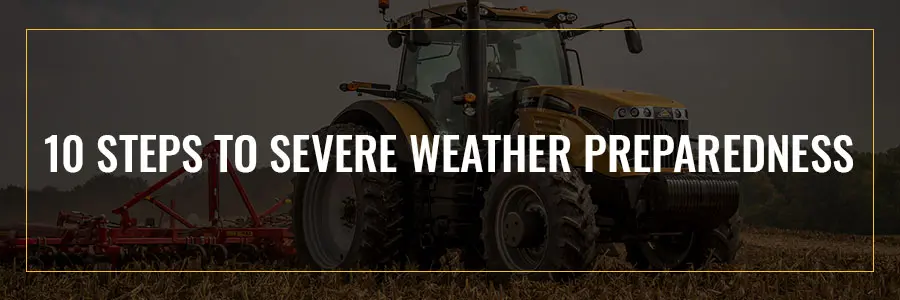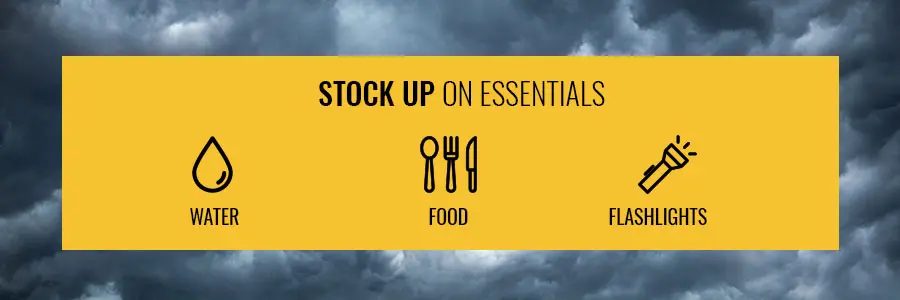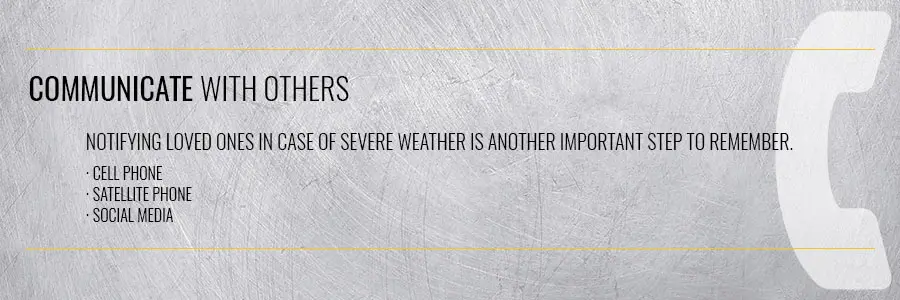How to Prepare for Severe Weather in Construction
No matter where you live, you’re likely to encounter some form of severe weather. At its worst, severe weather can cause serious injuries or fatalities. In 2017, 508 people died and 1,205 were injured due to severe weather in the United States.
Severe thunderstorms, flash flooding, sustained winds and other severe weather hazards can leave you feeling panicked and scrambling if you don’t know what to do. There’s no reason to feel helpless when severe weather strikes, however — while the weather itself is out of your control, your response is not. If you want to know how to plan for these situations so that you’re ready when the time comes, follow these 10 severe weather preparedness tips.
1. Have a Plan
Too many people make the mistake of waiting until severe weather catches them off guard instead of planning ahead. Especially if you have a family, it’s extremely important that you discuss what you would do and where you would go in a severe weather situation. Depending on the type of weather and level of threat, you could be evacuated from your home, neighborhood or city. Often, this results in families being separated from one another.
Hurricane Katrina in 2005 resulted in 5,000 reports of missing children. You should form a plan for each evacuation scenario (home, neighborhood or city) and stay aware of severe weather procedures at your family members’ schools and workplaces. When you have a plan, your family members won’t have to wonder where to find you no matter what happens.
Make sure your loved ones know how to prepare for severe weather and what to do when hazardous weather strikes. The Federal Emergency Management Agency (FEMA) has a great resource available called the Family Emergency Plan for developing a plan and having it on file.
Just verbally discussing a plan with your family is a good first step, but writing it down is even more foolproof. The document also has a place to write down important personal information that could help you locate your family members if you become separated. When you find yourself cut off from your loved ones and unable to communicate, all you have to rely on is your plan, so make sure you have one and that everyone knows what it is.
2. Know Where to Go
In the event of severe weather, you should make your way to the safest location on the premises. If your home or workplace has a basement, that’s probably the safest place to stay until the threat has passed. If you don’t have a basement, make your way to a room on the ground floor — such as a bathroom or closet — that does not have windows.
A good rule of thumb is to stay as close to the center of a building as possible. Even outside walls that don’t have windows are not as safe as interior walls.
When identifying interior rooms that don’t have windows, if you have a choice between a bathroom and closet, opt for the bathroom, since the plumbing in the walls gives you an extra line of defense. Especially if you live in a location where tornadoes are common, you may want to consider installing a storm shelter on your property or a safe room in your house.
Your school or workplace should have a plan in place that dictates where people should go during weather emergencies. It should prioritize severe weather awareness for all students/employees. If you haven’t gone through a practice drill recently, check to make sure you know where you should go when severe weather strikes. Knowing where to go ahead of time will keep you calm and confident instead of panicked.
3. Stock up on Essentials
Another important aspect of being prepared is to ensure you have essential items on hand. Make sure you have access to these items at all times:
- Water: Tap water can become contaminated by storm damage. If you have a well with an electric pump, a power outage will shut off your access to water. Since it’s essential you can’t go without, you need to make sure you stay stocked up on fresh water that won’t be affected by a storm. You need one gallon of water per person per day. You should plan for at least three days, so if you have a family of four, you should have a dozen gallons of drinking water ready to go.
- Food: You should have enough food to last your family three days. Do not opt for refrigerated or raw foods. Canned goods are perfect since they have an extremely long shelf life, and non-acidic foods especially can last for many years. In most cases, as long as the can itself is in good shape, the food inside is safe to eat. The USDA offers a comprehensive guide on shelf-stable food safety that can help answer your questions about how long foods last and how to know if something is safe to eat.
- Flashlights and batteries: You should always have flashlights and fresh batteries on hand in the event of a blackout. You can also keep crank lanterns as a backup lighting method. Make sure you know where these items are located in your home, and keep some either inside or close to the safe location you plan to occupy during a storm.
4. Prepare for an Outage
Knowing what to check for before severe weather hits is an important step in being prepared. Storms often cause power outages, so in severe weather, you should be ready to potentially lose power to your house.
When you know you may lose power, go through your house and unplug appliances. You should always leave appliances unplugged when they’re not in use. You should also use surge protectors for valuable appliances and electronics, like your computer and TV. Alternatively, you can plug these electronics into their own grounded circuit to safeguard them against the fluctuation of a large appliance like a refrigerator starting back up when power returns.
When you anticipate a potential power outage, turn off your propane tank, and make sure you have a full gas tank for a generator. You’ll also want to have plenty of gas in your vehicle in case you need to go somewhere. Finally, dial up the cold settings on refrigerators and freezers to keep food cold longer.
5. Communicate With Others
Notifying loved ones in case of severe weather is another important step to remember. When friends and loved ones learn about the severe weather in your area, they’ll want to know that you’re safe. Instead of waiting until they experience anxiety over your situation, proactively contact them to let them know you’re safe. Landlines are often affected by severe weather, so don’t rely solely on your home phone. There are several other ways you can communicate, including:
- Cell phone: Whether you text or call, a cell phone is a great way to reach out to people. Make sure your cell phone is charged when you anticipate bad weather. You can conserve battery life by using your phone’s settings to activate a power-saving mode. To be fully prepared, you should keep a portable, battery-powered charger on hand to use when your phone’s battery is depleted.
- Satellite phone: If you live in an area that has little or no cell service, you should consider getting a satellite phone. These phones connect to orbiting satellites instead of grounded cell towers. They can be rather expensive but are worth having when you need to get in touch with someone.
- Social media: If you have internet access through either WiFi or mobile data, you can inform a whole host of people of your safety by posting on social media. Facebook even allows you to mark yourself as safe during crisis situations where people may be concerned for your safety.
6. Inform Yourself
It’s important to be aware of watches, warnings and advisories in your area and understand what each of these alerts means. When extreme weather hits, you may hear a siren. These sirens are to alert you of danger, but it’s up to you to learn more about what’s going on. You can stay up-to-date on the weather in your area in a few different ways:
- Watch: If your power is on, you can watch a local weather station for live updates.
- Listen: You can listen to local radio stations covering the weather or to National Oceanic and Atmospheric Administration (NOAA) weather radio. A NOAA weather radio will turn on any time, night or day, to alert you to a severe weather situation. If you have a newer mobile device, you probably automatically receive Wireless Emergency Alerts (WEA) that sound through your phone.
- Check: Finally, you can check on weather updates online or through a mobile app. There are many weather apps to choose from, including one from NOAA. If you live in Alabama, check the National Weather Service’s web page for Alabama. This page is updated continuously with weather information for various cities throughout the state.
7. Stay Put
In certain situations, like when a serious hurricane is expected, you may be advised to evacuate your home before the storm arrives. You should always heed these warnings and put your family’s emergency plan into effect. However, if you find yourself in the midst of a storm, you’re typically better off to remain at home.
Staying put during severe weather is an important safety measure that, if ignored, could result in disaster. Approximately 75 people die every year from attempting to drive through flooded roads. Some people may think they can get away with driving through water if they have four-wheel drive, but in flooding, four-wheel drive isn’t enough to protect you.
One foot of moving water is usually enough to overpower your vehicle and sweep it away. For most passenger cars, six inches of water is enough to make you lose control and cause your car to stall. Traveling on foot can also be dangerous. It doesn’t take much rushing water to knock you off your feet and carry you downstream. Even if it isn’t flooding, heavy rains or high winds can still make for extremely dangerous driving conditions.
Sometimes, you may not know when severe weather is going to strike. If you find yourself on the road in such conditions, carefully move off the road, park in a safe location and turn your hazards on. Turn on your radio to learn more about what’s happening. If the conditions suggest a tornado may be near, make sure to leave your seat belt on and lean down to keep your head below your car’s windows. If you have a blanket nearby, use it to cover your head.
8. Check for Damage
You should inspect your home after severe weather to check for damage. Wait until after the storm has passed and it’s safe to emerge from your safe location. Then, go through your home and around the outside of it to look for signs of damage. If you come across any, take photographs to document it. Pay special attention to windows, doors and your roof, as these are all parts of your home that are more vulnerable to storm damage.
You should also contact your local emergency management agency. These agencies can sometimes help cover expenses not covered by your insurance. If you are an Alabama resident, contact the Alabama Emergency Management Agency to seek assistance.
Since storms can cause problems for city water supplies and wells, don’t drink or cook with water from your faucet right away. Wait until you know whether the water is safe. If you need water but think it may be contaminated, treat it first, just in case. The Center for Disease Control and Prevention (CDC) has a guide on how to treat contaminated water to make sure it’s safe before you drink it or cook with it.
9. Help Others
When a community is affected by severe weather, it’s important to come together to receive and give help in order to safely get through the crisis.
During a storm, try to check on your neighbors to make sure they’re safe. If you’re fortunate enough to have extra provisions, such as drinking water, consider sharing with others in need. If you have a generator, allow your neighbors to come over to use your electricity to recharge their phones. If you have a heat source and it’s cold outside, invite them to gather inside your house.
When severe weather leaves damage in its wake, do what you can to engage with relief efforts. Contact your local emergency management agency to see how you can help. Another way you can help is through the American Red Cross’s disaster services. By taking classes to become a disaster action team (DAT) member, you can be ready to help respond to local disasters and be deployed out to national disasters.
10. Own a Generator
Last, but certainly not least, you should prepare for severe weather by purchasing a generator. During Hurricane Sandy, more than eight million homes across 17 states lost power. A generator could have kept the lights on for each of those houses. Not only will a generator keep your lights on, but it will also allow you to operate important appliances like sump pumps and heaters.
Portable generators come in different sizes, so you can find one that will meet your needs and stay within your budget. Most portable generators cost somewhere in the range of $400 to $1,000, but you can spend more if you want a more powerful generator.
This tool from Cat® will help you determine the amount of wattage you’ll need to run various home appliances and electronics. Generators tend to sell fast when severe weather is imminent, so don’t wait until the last minute to equip your home with backup power. Buy a generator now so that you don’t have to worry when you experience a power outage.
Once you purchase a generator, you’ll need to install it so that it’s ready to go. The safest and best way to do so is to have an experienced electrician install a transfer switch to plug your generator into. This switch is wired into your home’s service panel and able to send power only to the circuits in your house that you’ve designated. Flipping the switch also disconnects your house from the outside grid and keeps your generator’s power from flowing outside.
When running your generator, make sure it is outside at least 10 feet away from your house. To prevent theft, keep it chained to a heavy object. When your generator is being stored, don’t leave fuel in it. Do, however, keep plenty of fuel on hand for when you need it. Restoring power with a generator following a severe weather event is one of the best ways you can minimize the effects of a storm on yourself and your family. It would be hard to overestimate the value of a generator during severe weather!
Get Started Today
You never know when severe weather may strike, so it’s important to be prepared. Don’t wait until you and everyone around you become frantic over a threat of severe weather. Follow the 10 steps outlined here to get started developing a plan and making sure you have everything you need to stay safe during a severe weather situation so that it doesn’t become a crisis.
Looking for portable energy solutions?
Get the quality equipment you need when you need it. View our equipment online or contact us for fast local service.
Contact Us






